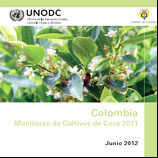Please consider using Chrome, Edge, Safari or Firefox.
 25 July 2012 - The area under coca crop cultivation in Colombia rose 3 per cent in 2011 to 64,000 hectares (ha), up by 2,000 ha compared with 2010. Overall, the picture, therefore, remained stable for the raw material used in the production of the illegal drug cocaine.
25 July 2012 - The area under coca crop cultivation in Colombia rose 3 per cent in 2011 to 64,000 hectares (ha), up by 2,000 ha compared with 2010. Overall, the picture, therefore, remained stable for the raw material used in the production of the illegal drug cocaine.
The 2011 survey shows that while the area used for coca leaf cultivation decreased in 14 of the 24 departments of Colombia, that trend did not offset increases in 6 other departments. In 4 departments, no major change was observed.
Almost two-thirds (62 per cent) of coca cultivation was concentrated in only 4 departments - Nariño, Putumayo and Cauca bordering Ecuador to the west and Guaviare to the south - but all witnessed an increase in cultivation. The Putumayo-Caquetà region saw a rise of 80 per cent in cultivation, from around 7,360 ha in 2010 to almost 13,280 ha in 2011. In contrast, the central region, particularly Antioquia and Córdoba provinces, saw the sharpest declines in cultivation, dropping 31 per cent from some 15,300 ha in 2010 to around 10, 640 ha in 2011. The areas along the Pacific coast remained stable.
In 2011, the Government manually eradicated 34,170 hectares of coca bush and sprayed a total of 103,302 hectares. While aerial spraying remained at 2010 levels, manual eradication decreased by 22 per cent.
Recent studies show that the coca leaf yield per hectare has decreased, probably because farmers are cutting back on fertilizers and agro-chemicals. Thus, potential cocaine production in 2011 remained stable at 345 tons, down 1 per cent from 350 tons in 2010.
The farm-gate value of coca leaf and derivatives (coca paste, cocaine base) in 2011 was estimated at US$420 million, worth around 0.2 per cent of GDP.
The average net income from coca of a farmer selling coca leaf is close to $2 per day, close to the threshold of extreme poverty set by the international community. This indicates that small-scale coca crop growers benefit very little from the lucrative cocaine business. The number of households involved in coca cultivation fell 2 per cent from 63,660 in 2010 to 62,400 in 2011.
UNODC has supported the Government of Colombia in monitoring coca cultivation since 1999. The annual survey supported by UNODC is mainly based on data derived from satellite imagery and field surveys to measure the production of coca leaf.
Full Report : Colombia Monitoreo de Cultivos de Coca 2011 Junio 2012 (pdf)
Full Report (English) : Colombia Coca cultivation survey 2011 June 2012 (pdf)